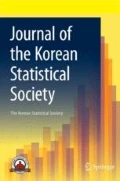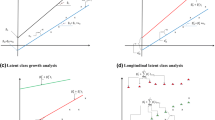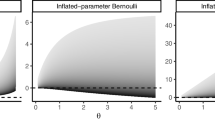Abstract
By introducing the notion of “empirical likelihood function of observing sums”, unequally-spaced time series data and longitudinal data generated from Lévy processes can be analyzed. Characteristic function is further incorporated to handle the situations where the density function of the increments is difficult to obtain. In the situations where both characteristic function and the density function are available, it is shown through the simulation examples that the proposed empirical maximum likelihood method does not suffer from significant information loss comparing to the maximum likelihood estimation method. The performances of the proposed method is tested for both equally-spaced and unequally-spaced observations.


Similar content being viewed by others
References
Achcar, J. A., Coelho-Barros, E. A., Cuevas, J. R. T., & Mazucheli, J. (2018). Use of Lévy distribution to analyze longitudinal data with asymmetric distribution and presence of left censored data. Communications for Statistical Applications and Methods, 2018(25), 43–60.
Chan, N. H., Chen, S. X., Peng, L., & Yu, C. L. (2009). Empirical likelihood methods based on characteristic functions with applications to Lévy processes. Journal of the American Statistical Association, 104(488), 1621–1630.
Cont, R., & Tankov, P. (2004). Financial Modeling with Jump Processes. New York: Chapman & Hall/CRC.
Diggle, Peter J., Liang, Kung-Yee, & Zeger, Scott L. (1994). Analysis of Longitudinal Data. Oxford: Oxford University Press.
Eckner, A. (2014). A Framework for the Analysis of Unevenly Spaced Time Series Data, Unpublished paper.
Elgin, H. (2011). Lévy Processes and Parameter Estimation by Maximum Empirical Likelihood.
Heathcote, C. R. (1977). The integrated squared error estimation of parameters. Biometrika, 64(2), 255–264.
Jones, R. H. (1985). Time Series Analysis with Unequally Spaced Data. In E. J. Hannan, P. R. Krishnaiah, & M. M. Rao (Eds.), Handbook of Statistics (Vol. 5, pp. 157–177).
Lee, Y., Nelder, J. A., & Pawitan, Y. (2006). Generalized Linear Models with Random Effects: Unified Analysis via H-likelihood. New York: Chapman & Hall/CRC.
Li, J., Wang, Z., Liu, X., Zhang, Y., Fu, H., & Liu, C. (2016). A Wiener process model for accelerated degradation analysis considering measurement errors. Microelectronics Reliability, 65, 8–15.
Liu, Qing, & Pierce, D. A. (1994). A note on gauss-hermite quadrature. Biometrika, 81(3), 624–629.
Liu, Z. (2016) Time Series Modeling of Irregularly Sampled Multivariate Clinical Data. Ph.D. Dissertation.
Merton, R. C. (1976). Option pricing when the underlying stock returns are discontinuous. Journal of Financial Economics, 3, 125–144.
Nunez-Anton, V., & Woodworth, G. G. (1994). Analysis of longitudinal data with unequally spaced observations and time- dependent correlated errors. Biometrika, 50(2), 445–456.
Pinheiro, J. C., & Bates, D. M. (2000). Mixed-effects Models in S and S-PLUS. New York: Springer.
Parzen, E. (Ed.). (1984). Time Series Analysis of Irregularly Observed Data (Vol. 25, pp. 158–188). Lecture Notes in Statistics, New York: Springer.
Rehfeld, K., Marwan, N., Heitzig, J., & Kurths, J. (2011). Comparison of correlation analysis techniques for irregularly sampled time series. Nonlinear Processes in Geophysics, 18, 389–404.
Shu, Y., Feng, Q., Kao, E. P. C., & Liu, H. (2016). Lévy-driven non-Gaussian Ornstein–Uhlenbeck processes for degradation-based reliability analysis. IIE Transaction, 48, 993–1003.
Sueshi, N., & Nishiyama Y. (2005). Estimation of Lèvy processes in mathematical finance: A comparative study. mssanzorgau, pp. 953–959.
Vališ, D., & Mazurkiewica, D. (2018). Application of selected Levy processes for degradation modelling of long range mine belt using real-time data. Archives of Civil and Mechanical Engineering, 18, 1430–1440.
Zhang, Z., Si, X., Hu, C., & Lei, Y. (2018). Degradation data analysis and remaining useful life estimation: A review on Wiener-process-based methods. European Journal of Operational Research, 271, 775–796.
Acknowledgements
Chi Tim, Ng’s work is supported by National Research Foundation of Korea (NRF) grant funded by the Korea government (MSIP) (No. NRF-2017R1C1B2011652).
Author information
Authors and Affiliations
Corresponding author
Additional information
Publisher's Note
Springer Nature remains neutral with regard to jurisdictional claims in published maps and institutional affiliations.
Appendix
Appendix
1.1 Integration via adaptive Gauss Hermite (AGH) quadrature method
In this appendix, adaptive Gauss Hermite (AGH) quadrature method (see Liu and Pierce 1994) is described for the evaluation of the integral in (18). Denote by \(\exp [-G( {b})]\) the integrand. This means that
The gradient and Hessian of \(\mathcal {L}(\varvec{\theta }_{i\ell }(b);Y_{i\ell })\) will be given later on. Choose \(b_0 = \arg max_{b} \left[ -G( b) \right]\). Let \(y=(b- b_0)\sqrt{ G{''}(b_0 )/2 }\) and \(\sigma =\sqrt{ 1/G{''}(b_0 )}\). Then, \(b =b_0+ \sqrt{2} \sigma \cdot y\) and \(db = \sqrt{2} \sigma dy\). Consider
On the right-hand-side of (A.1), the values of \(w_s\) and \(y_s\) for \(j=1,2,\dots ,r\) can be obtained easily using R package fastGHQuad. In the computation, \(r=4\) nodes are used.
Below, the gradient and Hessian of \(\mathcal {L}(\varvec{\theta }_{i\ell }(b);Y_{i\ell })\) are given. For brevity, we suppress the notation of i and \(\ell\) and write \(\mathcal {H}_j(b)\) for \(\mathcal {H}(U,\frac{\Delta Y_{ij\ell }}{\Delta T_{ij}},\varvec{\theta }_{i\ell }(b))\,.\) The notation \(\partial\) refers to the first order derivative with respect to a component of b and \(\partial ^2\) refers to the second order derivative with respect to one or two components of b. Then, \(\mathcal {L}(\varvec{\theta }_{i\ell }(b);Y_{i\ell })\) can be rewritten as
Here, \(\eta (b)\) is obtained from Eq. (15) and thus fulfills
Then, the first order derivative is
The second order derivative is
Differentiating (A.3) with respect to b yields
\(\partial \eta (b)\) can therefore be solved from the above system of linear equations.
Rights and permissions
About this article
Cite this article
Park, J.K., Ng, C.T. & Na, M.H. Empirical likelihood method for longitudinal data generated from unequally-spaced Lèvy processes. J. Korean Stat. Soc. 49, 1008–1025 (2020). https://doi.org/10.1007/s42952-019-00047-3
Received:
Accepted:
Published:
Issue Date:
DOI: https://doi.org/10.1007/s42952-019-00047-3




